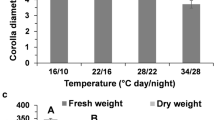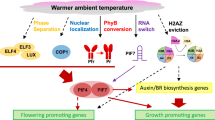Abstract
The flowers or inflorescences of certain primitive seed plants are able to regulate their temperature during blooming by modulating the rate of heat production to remain much warmer than the surroundings. A large drop in ambient temperature causes a smaller drop in flower temperature which causes an increase in the rate of heat production by futile involvement of the cytochrome and alternative oxidase respiratory pathways. The result is that the rate of heat production is inversely related to ambient temperature and flower temperature remains high and relatively independent of ambient temperature. While the biophysics of thermal balance in the whole flowers is better understood, the regulation of the biochemical heat-generating pathways is not known.
Similar content being viewed by others
REFERENCES
Chauveau, M., Dizengremel, P., and Lance, C. (1978) Thermolability of the alternative electron transport pathway in higher plant mitochondria. Physiol. Plant. 42:214-220.
Day, D. A., Whelan, J., Millar, A. H., Siedow, J. N., and Wiskich, J. T. (1995) Regulation of the alternative oxidase in plants and fungi. Aust. J. Plant Physiol. 22:497-509.
Elthon, T. E. and McIntosh, L. (1986) Characterization and solubilization of the alternative oxidase of Sauromatum guttatum mitochondria. Plant Physiol. 82:1-6.
Elthon, T. E. and McIntosh, L. (1987) Identification of the alternative terminal oxidase of higher plant mitochondria. Proc. Natl. Acad. Sci. USA 84:8399-8403.
Elthon, T. E., Nickels, R. L., and McIntosh, L. (1989) Mitochondrial events during the development of thermogenesis in Sauromatum guttatum (Schott). Planta 180:82-89.
Gottsberger, G. (1990) Flowers and beetles in the South American Tropics. Bot. Acta 103:360-365.
Knutson, R. M. (1974) Heat production and temperature regulation in eastern skunk cabbage. Science 186:746-747.
Knutson, R. M. (1979) Plants in heat. Natural History 88:42-47.
Listabarth, C. (1996) Pollination of Bactris by Phyllotrox and Epurea. Implications of the palm breeding beetles on pollination at the community level. Biotropica 28:69-81.
Meeuse, B. J. D. and Raskin, I. (1988) Sexual reproduction in the arum lily family, with emphasis on thermogenicity. Sex Plant Reprod. 1:3-15.
Miyake, K. (1898) Some physiological observations on Nelumbo nucifera, Gærtn. Gærtn. Bot. Mag. Tokyo 12:112-117.
Moore, A. L. and Siedow, J. N. (1991) The regulation and nature of the cyanide resistant alternative oxidase of plant mitochondria. Biochem. Biophys. Acta 1059:121-140.
Moynihan, M. R., Ordentlich, A., and Raskin, I. (1995) Chilling-induced heat evolution in plants. Plant Physiol. 108:995-999.
Nagy, K. A., Odell, D. K., and Seymour, R. S. (1972) Temperature regulation by the inflorescence of Philodendron. Science 178:1195-1197.
Nobel, P. S. (1999) Physicochemical and Environmental Plant Physiology. New York: Academic Press.
Prance, G. T. and Arias, J. R. (1975) A study of the floral biology of Victoria amazonica (Poepp.) Sowerby (Nymphaeaceae). Acta Amazonica 5:109-139.
Raskin, I., Ehmann, A., Melander, W. R., and Meeuse, B. J. D. (1987) Salicylic acid: a natural inducer of heat production in Arum lilies. Science 237:1601-1602.
Schneider, E. L. and Buchanan, J. D. (1980) Morphological studies of the Nymphaeaceae. XI. The floral biology of Nelumbo pentapetala. Am. J. Bot. 67:182-193.
Schroeder, C. A. (1978) Temperature elevation in palm inflorescences. Principes 22:26-29.
Seymour, R. S. (1999) Pattern of respiration by intact inflorescences of the thermogenic arum lily Philodendron selloum. J. Exp. Bot. 50:845-852.
Seymour, R. S., Bartholomew, G. A., and Barnhart, M. C. (1983) Respiration and heat production by the inflorescence of Philodendron selloum Koch. Planta 157:336-343.
Seymour, R. S. and Blaylock, A. J. (1999) Switching off the heater: influence of ambient temperature on thermoregulation by eastern skunk cabbage Symplocarpus foetidus. J. Exp. Bot. 50:1525-1532.
Seymour, R. S. and Schultze-Motel, P. (1996) Thermoregulating lotus flowers. Nature 383:305.
Seymour, R. S. and Schultze-Motel, P. (1997) Heat-producing flowers. Endeavour 21:125-129.
Seymour, R. S. and Schultze-Motel, P. (1998) Physiological temperature regulation by flowers of the sacred lotus. Phil. Trans. Roy. Soc. Lond. B 353:935-943.
Seymour, R. A. and Schultze-Motel, P. (1999) Respiration, temperature regulation and energetics of thermogenic inflorescences of the dragon lily Dracunculus vulgaris (Araceae). Proc. Roy. Soc. Lond. Ser. B. Biol. Sci. 266:1975-1983.
Seymour, R. S., Schultze-Motel, P., and Lamprecht, I. (1998) Heat production by sacred lotus flowers depends on ambient temperature, not light cycle. J. Exp. Bot. 49:1213-1217.
Siedow, J. N. and Berthold, D. A. (1986) The alternative oxidase: a cyanide-resistant respiratory pathway in higher plants. Physiol. Plant. 66: 569-573.
Skubatz, H., Tang, W., and Meeuse, B. J. D. (1993) Oscillatory heat-production in the male cones of cycads. J. Exp. Bot. 44:489-492.
Skubatz, H., Williamson, P. S., Schneider, E. L., and Meeuse, B. J. D. (1990) Cyanide-insensitive respiration in thermogenic flowers of Victoria and Nelumbo. J. Exp. Bot. 41:1335-1339.
Steponkus, P. L. (1981) Responses to extreme temperatures. Cellular and sub-cellular bases. In: Physiological Plant Ecology I (O. L. Lange, P. S. Nobel, C. B. Osmond, and H. Ziegler, eds.), Springer-Verlag, Berlin, pp. 371-402.
Thien, L. B., Azuma, H., and Kawano, S. (1999) New perspectives in the pollination biology of basal angiosperms. In: XVI International Botanical Congress. St. Louis.
Vanlerberghe, G. C. and McIntosh, L. (1992) Lower growth temperature increases alternative pathway capacity and alternative oxidase protein in tobacco. Plant Physiol. 100:115-119.
Author information
Authors and Affiliations
Rights and permissions
About this article
Cite this article
Seymour, R.S. Biophysics and Physiology of Temperature Regulation in Thermogenic Flowers. Biosci Rep 21, 223–236 (2001). https://doi.org/10.1023/A:1013608627084
Issue Date:
DOI: https://doi.org/10.1023/A:1013608627084




